Boat outboard maintenance can seem tricky and daunting, here’s how to save on maintenance costs and get it done quickly and efficiently!
How Much Does Outboard Maintenance Cost? Outboard maintenance costs will vary depending on the type of service being done. A full service including impellers will cost around $1000 per engine. Without Impellers will be around $500. This also depends on the service rate in your area.
This article will teach you everything you need to know about boat engine maintenance cost and how you can save money doing it!
How Much Does Boat Maintenance Cost?
Almost everyone wants a boat. But…
…not everyone wants to pay for the maintenance of the boat!
When it comes to the costs associated with boat maintenance, things can get expensive.
Thankfully, there are several methods you can use to save you some sweet cash in the process of taking care of your boat.
Before we dig into the details of how to save as much money as possible. When performing outboard maintenance, let’s define what “maintenance” really means, shall we?
Maintenance, or service, is the process of swapping out old parts of your engine for new ones. These parts are what are considered “service items.”
This change of parts keeps the engine running properly when items wear out or become dirty with continued use.
Your normal service items on a two-stroke engine include (but are not limited to) the following:
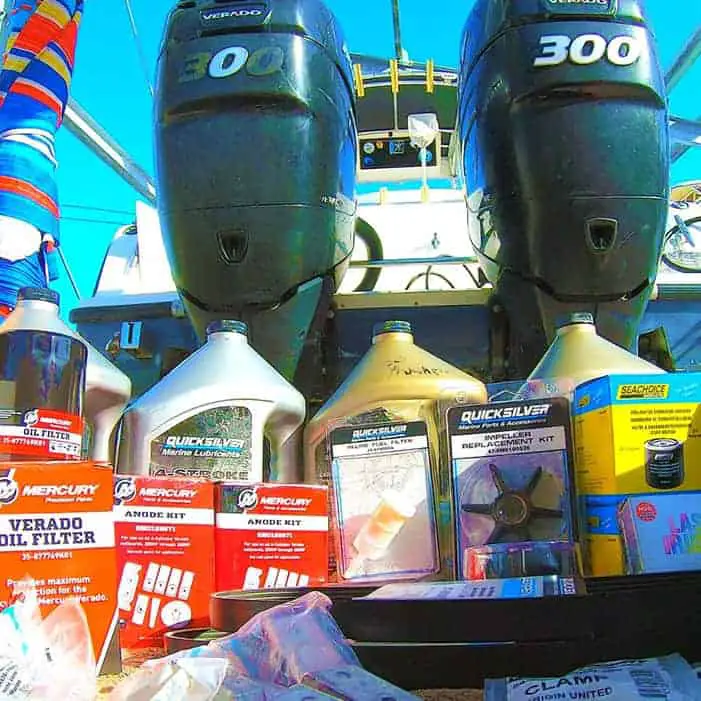
- Boat fuel filter
- Engine fuel filter
- Oil filters
- Air filters
- Thermostats
- Spark plugs
- Belts
- Water pump impellers
- Lower unit seals
- Sacrificial anodes or zincs (on the block, lower unit, and the engine bracket)
Depending on the age of the engine, the fuel-injected two-strokes will also have screens and filters on the Vapor Separator Tank.
While these aren’t necessarily considered “normal service items.” They are still considered “service items.”
Now, when it comes to a four-stroke engine, you typically have to service all of the exact same parts found in a two-stroke with the addition of the engine oil and oil filter.
Most people wonder why it costs more to maintain a four-stroke over a two-stroke.
Typically, we tend to service two-strokes a lot less. And the engine is less impacted when service is left undone for longer periods of time too!
This is because of the fact that the engine is burning oil and tends to be “oiler” on the inside. The oil helps to preserve parts that don’t get “oiled” or sprayed down with a protectant on a four-stroke.
How Often Should a Boat Be Serviced?
How often you should service your boat depends on your type of engine.
With a two-stroke, most of our services include changing the fuel filters, gear lube, and the spark plugs.
Impellers people will usually ride out for around five years and then we only change thermostats when we get an overheating issue.
Oil filters are usually buried so we don’t worry about changing them unless there is an issue originating from there. Can you see why it’s “cheaper” to maintain a two-stroke?
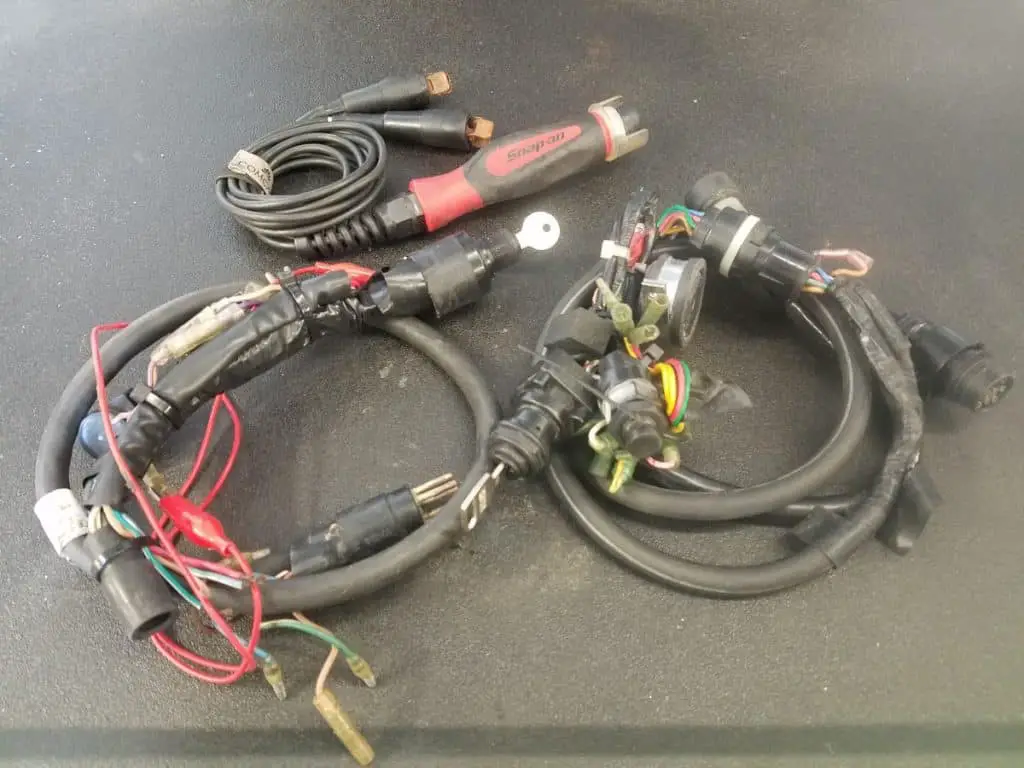
Some additional reasons why a four-stroke engine is more expensive to service:
Some of the parts on a four-stroke are more expensive than it’s two-stroke counterparts.
These more expensive parts usually include the spark plugs. On a conventional two-stroke engine, spark plugs need to be swapped much more often than on a four-stroke.
Here’s the catch: plugs for a two-stroke cost around $3 apiece, whereas those on a four-stroke can cost up to over $20 per plug!
If we compare oil filters, the two-stroke filter costs around $14 whereas the four-stroke filter is in the $20 range.
So, although it may not seem like that big of a price difference, remember these parts are regularly swapped out. The costs are compounding and build over time!
The OEM requirement for service is for filters and oils every 100 hours or once a year. Then for the belts, plugs, impellers, and thermostats. Once every 300 hours or every 3 years.
It’s extremely important to do these services because expensive parts like gear cases do not have a warning if a seal fails. If you don’t regularly change the lube.
You could get water in the gear case and end up blowing it up! Here’s some more information on How To Tell If You Have A Gearcase Seal Failure!
How Much Does It Cost To Service An Outboard Motor?
Let’s talk about saving you some green $ when servicing.
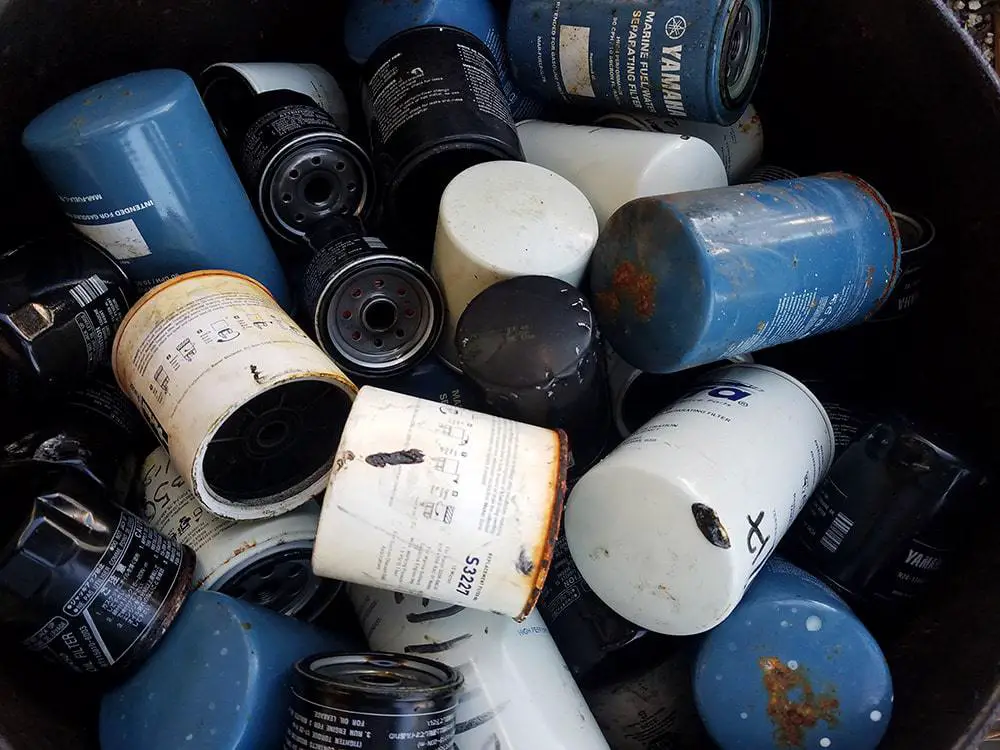
Our first tip in saving as much money as possible when servicing your engine is to simply keep a log of your service records.
This doesn’t have to be a rocket-launch checklist. In fact, you only really need to keep track of three main pieces of information:
- How many hours are on the engine at the time of service
- What was the date of the service
- Exactly what components got changed during the service
A little organization goes a LONG way when it comes to boat maintenance.
If you want to save money on the maintenance cost per year, then you’ll need to get creative on how to do it by playing around with the log. Let me explain.
Most of the time, if you are paying a shop or mechanic to service your boat, there is a labor charge involved.
Whether the labor cost is $100 an hour or $150 an hour, there is always going to be a charge for the time the mechanic was involved with your service.
Generally, the time rate involved with servicing an engine is roughly 2.5 hours (without servicing impellers or thermostats).
When the impellers are swapped, the lower units on the engine have to be removed in order to be changed.
Hence, the time it takes to service the impellers is usually an extra 2 hours per engine!
It’s important to also keep in mind: things like salt build-up, corrosion, and broken bolts or parts can add to the labor expense as more time will need to be invested in your service.
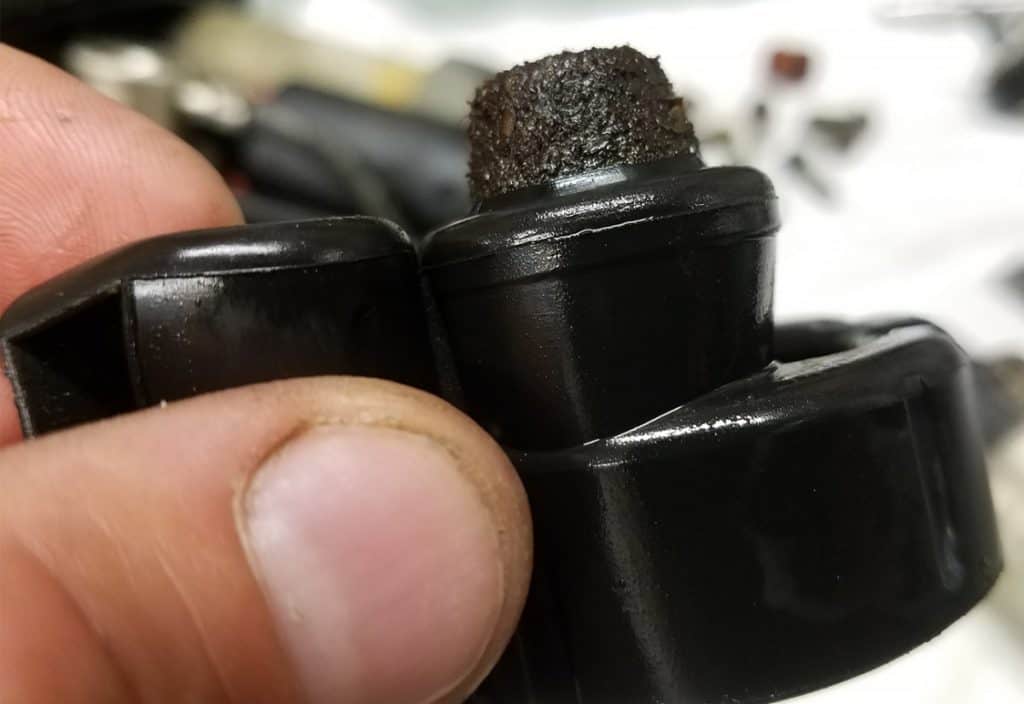
So, crunching some conservative measurements, we are looking at about 4.5 to 5 hours per engine for a full service with impellers.
At an extremely competitive rate of $100 an hour, we’re looking at $500 plus the cost of the parts, as well as tax!
All said and done, this can put your engine service at around a thousand dollars or more.
This is considering a low hourly rate. For example, down here in the Florida keys, most shops charge an average of $175 per hour of labor.
This brings us back to the question of how to save money on this expensive task…
There are three main ways to cut costs when it comes to outboard maintenance.
Scheduling, parts purchasing, and labor.
How Long Does An Outboard Motor Last?
On average, most modern outboard gas engines are now lasting over 3,000 hours! On average! Then others we see get up well over 5,000 hours and more!
For more information on how long engines last, read our article here on How To Get More Hours From Your Outboard!
Proper care and maintenance of your engine can lead to a much longer engine life.
When it comes to maintenance, you can save money on a yearly basis by simply scheduling and performing maintenance on your engine at the right time.
Using your service log or records that you keep. We know what the service items that need to be replaced are and which we won’t change. However, we can still play with how we service them and when.
In our opinion, the best way to save money by organizing your service dates is by splitting up the maintenance in two.
We’ll always be doing the gear lube, the oil change, oil filter on four-strokes, and fuel filters at every service period. However.
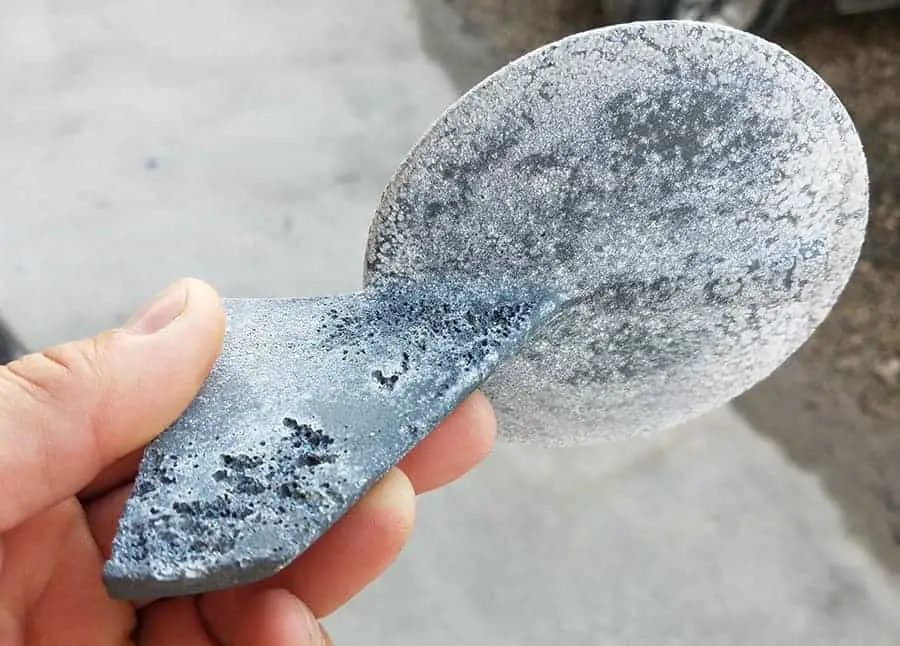
We can split how we do the impeller, thermostats, spark plugs, belts, and anodes.
The anodes are a typically a visual inspection type of item. We’ll usually pull one out and inspect it and only change them if they need to be changed. Usually when they are 50-70% corroded.
We recommend you do the anodes, belts and spark plugs together. Then do the thermostats and the impeller the next time.
Here’s where the savings come in…
The cost of labor, impellers, seals, and thermostats together is about equal to the cost of the anodes, plugs, and belts.
You can spread the expense by scheduling half the expensive parts during one service and the other half the next.
Essentially, you are equalizing the cost per year over every year.
In other words, instead of one year costing $1000 in service and the next year costing $500, we’ll split it up and it will cost an even $750 per year, every year.
This will save you more money per year by keeping more cash in your hand, instead of having a large, and expensive service all at once!
An additional benefit to scheduling your service dates is knowing exactly when your service will be, and what you will need to do to your boat (giving you more time to save).
How Much Should I Budget For Boat Maintenance?
Everything we’ve discussed so far allows you to save money on parts and maintenance.
Thanks to the service schedule date sheet, you can be prepared.
Now, you can order your parts online while saving a significant amount on them.
You can simply keep them in hand when it comes time to do the next service.
NOTE: When I say in hand, that doesn’t mean left on the boat for 6 months sitting in a puddle of water rusting away!
We’ll save money here because the MSRP’s or OEM price set by the manufacturer will always stay the same. As opposed to buying parts directly from your servicer.
This is because dealers, marinas, shops, and servicers will all have some variance in the cost of the parts.
This is usually based on location, the overhead expenses of the shop, the handling of the parts, and the taxes that go along with distributing parts.
Whereas purchasing parts directly from manufacturers or distributors online cuts out overhead expenses and retailer price mark-ups.
Because a manufacturer or distributor is focused on the quantity of parts sold (as opposed to a servicer trying to make a profit on each part sold), this gives them the ability to sell the parts for a deeply discounted rate.
This brings us to the part where we can really save the most amount of money.
Do Boats Require A Lot of Maintenance?
While boats require servicing just like any other mechanical vehicle does, it’s all about getting the service done for as little as possible, right?
Saving the most amount of money when servicing your outboard is going to come in the form of labor. AKA DIYing the maintenance yourself.
It’s important to remember that about half, sometimes more of the total cost of servicing comes from the labor.
If you can cut the service bill in half by doing the work yourself, you will easily save a ton of money.
In all honesty, outboard services aren’t that daunting of a task either!
Actually, they are more of a “remove and replace” type of deal.
Once you know what parts need to be changed, where they’re located, and what you need to replace them, you’re mostly done! You are basically home free!
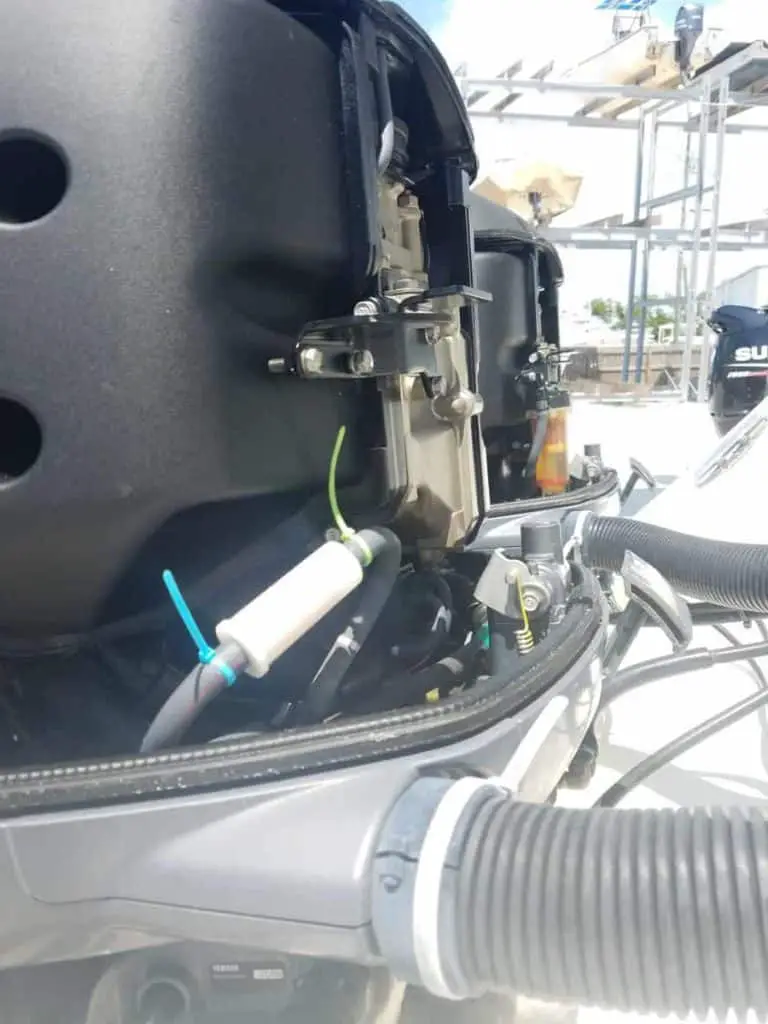
There are a ton of free online resources to help in tackling the servicing process. We have many service videos covering a range of different engines, horsepowers, and services on Our YouTube Channel!
Even if you tackle just a couple of the service items and have a professional perform the trickier stuff, you will be able to save money on maintenance expenses every year.
It’s up to you on what items you want to tackle. Learning to do most of the “remove and replace” items like spark plugs, belts, fuel filters, and thermostats can really help you here!
The bigger investment is going to be the cost of purchasing the tools you’ll need to do the service.
Although there aren’t many, they can be an additional expense. Your average wrench, ratchet and socket set, and a couple of filter wrenches will do just about any outboard that is on the market.
The upside to investing in your own service tools is the ability to perform services yourself at zero cost! It’s a buy once and forget it deal.
Realistically, it would take anyone about a day to learn how to completely service their engine. With only a few YouTube videos and maybe a couple of blog posts, anyone can learn how to service their engine.
A lot of the service can actually be done while the boat is in the water as well!
Utilizing your logging and scheduling, you’ll have the ability to perform services throughout the year. This avoids having to turn services into an entire weekend (or longer) process.
Now you know what is involved in performing outboard maintenance on your boat and the associated costs! You also know how to save money while doing it!
Check Us Out!
Check out our YouTube channel where we show you step-by-step videos on all things boating!
Now that you know about outboard maintenance, check out these other helpful articles packed full of information to help you with your boat!
